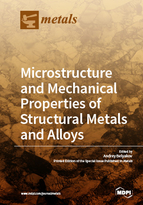Microstructure and Mechanical Properties of Structural Metals and Alloys
A special issue of Metals (ISSN 2075-4701).
Deadline for manuscript submissions: closed (30 April 2018) | Viewed by 112396
Special Issue Editor
Interests: structural steels and alloys; microstructure; grain boundaries; dislocation substructure; deformation and annealing behavior; strength and plasticity
Special Issues, Collections and Topics in MDPI journals
Special Issue Information
Dear Colleagues,
Mechanical properties of polycrystalline structural metals and alloys are significantly affected by their microstructural state, including phase content, grain/subgrain sizes, grain boundary distribution, dispersed particles and solutes, dislocation density, internal stresses, etc. Therefore, the studies on structure–property relationships are of a great practical importance. The development of metallic materials with desired structural state results in beneficial combinations of mechanical properties in accordance with exploitation conditions. Various thermo-mechanical treatments are generally used to produce metallic semi-products with suitable microstructures, which are developed owing to combined operation of diverse mechanisms of microstructure evolution. The effect of processing regimes/conditions and methods on the regularities of structural changes in metals and alloys should be studied in detail to supply materials scientists with a fundamental knowledge providing the progress in creation of novel techniques and optimization of conventional technologies of production of structural materials with enhanced unique properties. The aim of this Special Issue is to present the latest achievements in theoretical and experimental investigations of mechanisms of microstructural changes/evolutions in various metallic materials subjected to different processing methods and their effect on mechanical properties. The studies focused on the simulation and analysis of mechanical behavior of structural metals and alloys during exploitation are also welcome.
Dr. Andrey Belyakov
Guest Editor
Manuscript Submission Information
Manuscripts should be submitted online at www.mdpi.com by registering and logging in to this website. Once you are registered, click here to go to the submission form. Manuscripts can be submitted until the deadline. All submissions that pass pre-check are peer-reviewed. Accepted papers will be published continuously in the journal (as soon as accepted) and will be listed together on the special issue website. Research articles, review articles as well as short communications are invited. For planned papers, a title and short abstract (about 100 words) can be sent to the Editorial Office for announcement on this website.
Submitted manuscripts should not have been published previously, nor be under consideration for publication elsewhere (except conference proceedings papers). All manuscripts are thoroughly refereed through a single-blind peer-review process. A guide for authors and other relevant information for submission of manuscripts is available on the Instructions for Authors page. Metals is an international peer-reviewed open access monthly journal published by MDPI.
Please visit the Instructions for Authors page before submitting a manuscript. The Article Processing Charge (APC) for publication in this open access journal is 2600 CHF (Swiss Francs). Submitted papers should be well formatted and use good English. Authors may use MDPI's English editing service prior to publication or during author revisions.
Keywords
- Structural steels and alloys
- Microstructure and texture
- Deformation and annealing behavior
- Static/dynamic recovery and recrystallization
- Grain refinement
- Grain/subgrain boundaries
- Dislocations and internal stresses
- Mechanical properties
- Strengthening mechanisms






